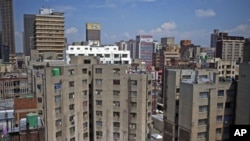Long labeled a "no-go zone," downtown Johannesburg - known as the CBD or Central Business District - is experiencing something of a revival. After decades of urban decay and high crime, galleries, restaurants and markets are opening again, and suburbanites are coming back to enjoy the city life.
Revival
Every weekend, this food market is packed. Two floors up, in a building on a main street in Johannesburg city center, this place is bustling with young adults and families, eating and drinking with a view on the street life. In a few weeks, they will be able to go visit a new museum, located just one street away.
In many cities, this is ordinary. But in Johannesburg, it's a little revolution; a sign that the inner city is becoming attractive again, after decades of abandonment.
As she walks amid the debris in a derelict office building, Angela Rivers checks on progress. Soon, it will be a residential building.
"It was very badly hijacked," she explained. "This area in particular was offices. And you'd have four-five people staying in each partition. On one floor, you could have anything between 150 to 200 people."
Apartheid and business exodus
Rivers works for AFHCO, a pioneer company specializing in affordable housing. Office buildings like this one are numerous in the inner city, also known as the CBD, the Central Business District.
In the 1980s, during the apartheid era, many businesses and residents left the congestion of the city-center and relocated to the suburbs. Black South Africans - who had been segregated - started to occupy the vacant buildings, because of the dramatic lack of decent housing.
Development Agency
Over the years, without government or policing action, the area fell prone to decay and crime.
Urban analyst Tanya Zack says that all began to change with the creation of the Johannesburg Development Agency.
"One of the big shifts has been residential development in the inner city, especially from the early 90s," said Zack. "The core CBD was a business center. What happens now, with the conversion of office blocks into residential development, is that we have people living here. That opens up the possibility of restaurants, shops."
And this has a direct effect on the crime, according to Zack.
"As the city becomes inhabited, and as more economic activity is possible and is generated in the city, there are more eyes on the streets, there is more vigilance. It does feel like a safer place," she said.
Safe streets, in turn, promote shops, trendy restaurants, libraries, and a vibrant cultural life.
As he prepares some tea, Lester Adams looks out the unobstructed view of the city from the window. This project manager and freelance curator has been living in the Joburg CBD for 2 and a half years.
"I lived in the west side of the city, in the suburbs, and I've always wanted to live in the city. It's a bit faster, more interesting, more exciting, more diverse," he said.
The new face of the inner city is slowly attracting more people like Lester - young and trendy people to more wealthy households attracted by the cheap price of accommodation.
Challenges ahead
But as more people move into the CBD, new challenges emerge, says AFHCO affordable housing CEO Renney Plit.
"With the increase of residential, there is an increased need for schooling, for parks, for public open spaces, and the city unfortunately has not come to the point with that, and that's something we're going to have to focus on going forward," said Plit.
Along with residential buildings, private investment is also doing well, thanks to an encouraging tax policy. Major companies such as Anglo Gold Ashanti have already moved their head offices into the CBD.
And more change is underway. To tackle the traffic congestion, the city is developing public transport with a new bus network. And soon, a high-speed train will connect the inner city with other hubs like the capital, Pretoria, and other business districts.




